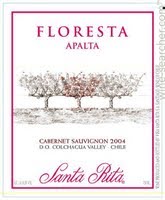Floresta wines, majestic and unique, are the result of the outstanding creativity from winemakers who strive to handcraft these remarkable wines by combining only the finest climate, soil and grape variety characteristics obtained from each of Santa Rita’s most exclusive terroirs, located in the best winelands of Chile.
Climate & Soils
Sub-humid Mediterranean climate with 400 mm of annual rainfall concentrated in the winter months. Summers are hot and dry. The rain and topography determine the heat summation during the growing period. Cold winds from the Andes Mountains give rise to a daily temperature oscillation with up to 20ºC (36ºF) difference between daytime highs and nighttime lows. The vineyards are located in the foothills with silty alluvial soils to a depth of 80 cm (31.5 in). These soils present moderate texture and sandy subsoil allow for good root development.
Vineyard Management
The Cabernet Sauvignon comes from vineyards that are more than 60 years old in the Apalta micro-valley. Part of the larger Colchagua Valley, Apalta is considered one of Chile’s most prominent areas for superior-quality wine production. Vineyard management is limited to trellising the vines to vertical shoot position, eliminating bunches over short shoots, and the early and total elimination of any bunches that may have been burned by the sun during the ripening in order to ensure the very best fruit for this wine. The non-irrigated vineyards have natural production which ranges from 2,000 to 2,500 kg/hectare.
Vinification and Aging
Harvest dates for both locations were determined through tasting. The objective is always to harvest with the maximum varietal expression and ripe tannins. The Cabernet Sauvignon was fermented at 26ºC with gently crushed berries in order to obtain the maximum extraction from the skins while preserving fruitiness. The must received three pump-over (remontage) per day at the beginning of the fermentation and was reduced to two per day toward the end, as determined by tasting. After completion of the fermentation, the wine remained on its skins for an additional 10 days and then racked to new French oak barrels, where it was aged for 15 months.








